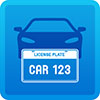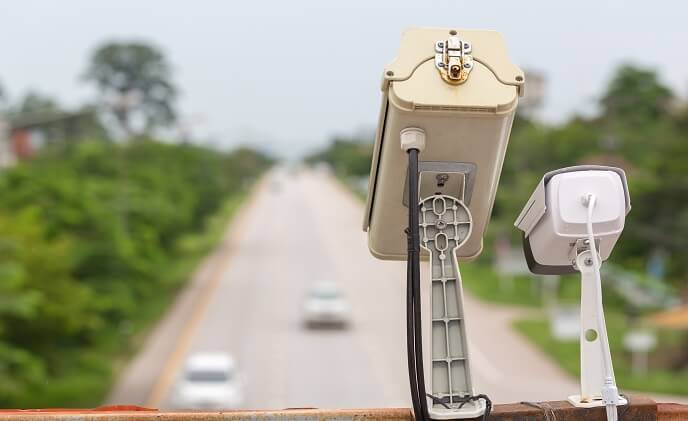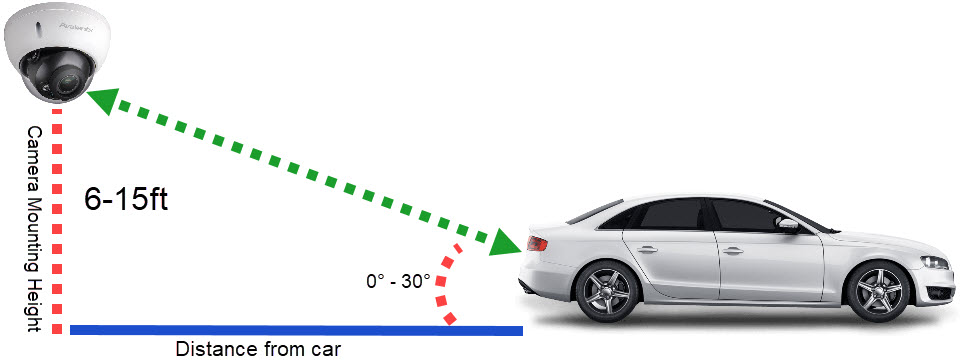
Security cameras capable of capturing license plates can be a challenge for any home or business that has concerns about prosecuting potential thieves or vandals. Technology is not quite there where we can have the Hollywood effect of capturing a plate super far away with amazing clarity. It takes a good amount of knowledge for setting up a surveillance camera to fully capture a license plate. This guide will provide some of the much needed information necessary to accomplish license plate capture.
What is a License Plate Capture Camera?
License plate capture cameras are also commonly referred to as license plate recognition cameras or LPR cameras. These are security cameras with specialized optics and shutter rates to allow the camera to clearly capture numbers and letters of license plates on still or moving vehicles. It is important to note that capturing does not mean converting the numbers in to a text file. It is simply the ability to visually see license plates clearly.
1. Choosing the right camera
Of course the first and most important step when considering license plate capture is choosing the right camera. There are tons of security cameras out there that will claim to have amazing detail and be able to capture anything and everything. This is hardly true when it comes to license plate capture.

Motion blur
Even HD security cameras cannot capture a plate when a vehicle is moving. A high resolution camera is made for general surveillance like capturing people or animals, not license plate on moving vehicles. This means the camera has a lower frame rate which leads to blurring when an object is moving faster than what the camera is tuned to. When blurring happens it becomes impossible to read text, and there is no way to enhance the picture. It is important to purchase a camera that allows for fine tuning of its shutter rate to allow plate capture from a moving vehicle. This can only be done by purchasing an actual license plate capture camera.
Day vs. Night limitations
Let’s say the security camera you have does use a high frame rate and can capture plates during the day, this will not be true at night. A camera with an automatic or static shutter rate will not be able to properly compensate for plate capture at night while the camera’s infrared LEDs are active. Night vision security cameras have too much IR light which creates a bright reflection, or glare on a license plate. A license plate camera will allow the user to set dual shutter rate control, i.e. a separate shutter rate setting for daytime and nighttime to prevent IR glare at night.
Dedicated Camera for License Plate Capture
A common misunderstanding about license plate capture is that a single camera can do it all. People who do not work with security camera systems every day may believe that any one security camera can be used to knock out multiple birds with one stone: capture license plates, be used for facial detail, and view general detail around their driveway or parking lot all at the same time. While we wish this was true and it would save money, it’s simply not possible.
Unless specified for license plate capture, surveillance cameras are engineered to capture good looking video in all sorts of lighting conditions for general viewing in a wide angle. Wide angles prevent cameras from seeing finer detail such as characters on a license plate that is far away. To capture license plates a specialized license plate camera is necessary. For general detail we recommend using a separate secondary camera that has a wide angle view.
 Source: Asmag
Source: Asmag2. Mounting the camera in a good location
Location is also extremely important to keep in mind when expecting to do plate capture. The camera must be looking at approaching or exiting vehicles so the angle between the camera lens and plates is no more than 15 degrees in the horizontal or vertical planes. If the camera is too far away to the side or mounted too high, the camera will not be able to provide a clear view of the plate. For best possible license plate capture, the camera will need to be looking directly head-on at the path of moving vehicles.

Distance and height
The distance between the camera and where you want to capture the plate will be the number one consideration for mounting the camera. Depending on the camera model, you would mount the camera at least 20ft away, and at most 150ft away from where the vehicles will pass. This depends on the lens and specifications for the camera. Please refer to the description and specifications of the camera you intend to purchase to determine how far you can expect to capture a plate from it.
Height is another important factor as you want to make sure the camera is not mounted too high up. Mounting it too high and looking down at a plate would be similar to looking at the top of someone’s head and expecting to see their face. Large height differences create issues where the text becomes obscured and unreadable. It is easier to read a license plate when the camera is looking directly at it.

3. Fine tuning camera settings
Once you have chosen the right license plate security camera for your application, and have mounted it correctly to ensure a proper view of passing vehicles, the last and most time consuming step is fine tuning of the camera’s settings. License plate cameras don’t have any magic algorithm to begin capturing perfectly clear video of passing license plates. The installer or user needs to spend time applying and testing different settings to ensure proper detailed capture that will up hold in court.
Zoom and Focus
First element to fine tune is the zoom level and focus of the camera. A license plate camera is meant to capture plate detail only, not the make and model of the vehicle or other general detail. If you are looking for general detail, a secondary camera is required. The license plate camera should be set to zoom in on the area of moving plates so that the plates are clearly visible when the video is paused and viewed in full screen mode. Plates appear more blurry during video, so make sure that the camera is zoomed in enough to provide a clear view of the plates at night.
Shutter Rate and IR LED Strength
License plate cameras by CCTV Camera World allow the user to specify shutter rate and IR LED strength that best fits the amount of lighting available at the location where the camera is mounted. As shown in the video below, we set a shutter rate that allows for a suitable view during the day, and at night when the IR LEDs turn on. Having too low of a shutter rate, would cause glare from the IR LEDs. We recommend setting these settings at night and making sure they work for a moving vehicle so the plate is not blurry. Once you have the desired settings set, leave the camera running till the next morning. When the sun is at its brightest, ensure the camera is displaying acceptable video during the day as well.

How to properly configure a license plate camera
In the video below we show how to configure our high speed license plate camera (sku IPD3MZ735) that can capture a license plate up to 150ft away on a vehicle moving up to 35mph. The steps below outline the functions performed in the video below on how to configure the camera’s image settings for good day and night capture.
- You would want to first configure the license plate camera at night
- Set a shutter rate in the image settings based on lighting in your application and how far away the car is
- Adjust the IR LED strength. Try using the default SmartIR and use manual settings if SmartIR doesn’t perform well
- The license plate should be at least 1/3 of the video frame
- Test the settings by trial and error with a car at night
- Test the same settings during the day to see if they work OR make a separate day and night schedule profile.
